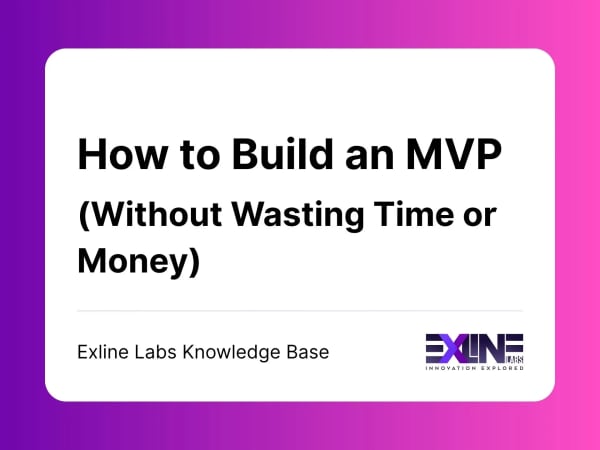MVP vs Prototype - What’s the Difference?

If you're building a new product, you've likely heard the terms MVP and prototype. They sound similar, and they're both used early in the product development process, but they’re not the same. This article breaks down the key differences, with real-world startup examples.
Date Published
12 Nov 2025
Date Updated
12 Nov 2025
Written By
Exline Labs Team
Reading Time
3 min read
Service Type
MVP DevelopmentIntroduction
If you're building a new product, you've likely heard the terms MVP and prototype. They sound similar, and they're both used early in the product development process, but they’re not the same.
Understanding the difference helps you:
- Save time and resources
- Validate ideas at the right stage
- Communicate clearly with investors or your team
This article breaks down the key differences, with real-world startup examples.
What Is a Prototype?
A prototype is an early, non-functional version of a product. It’s often used to:
- Demonstrate a concept or interface
- Test user flows or interactions
- Align stakeholders on design and UX
Types of prototypes:
- Low-fidelity wireframes
- Clickable mockups (Figma, InVision)
- Paper sketches
- Interactive demos (no backend logic)
Goal: Validate usability or design decisions.
What Is an MVP?
An MVP (Minimum Viable Product) is a working version of your product that:
- Solves a core problem
- Can be used by real customers
- Collects data and feedback
It has limited features, but it’s live and usable.
Goal: Validate product-market fit and real user demand.
MVP vs Prototype: Key Differences
| Feature | Prototype | MVP |
| Functional | No | Yes |
| Users | Internal/testers | Real customers |
| Purpose | Test design | Validate product idea |
| Data | Observational | Real-world usage |
| Build Time | Days–1 week | 2–6 weeks |
| Tools | Figma, Sketch, Adobe XD | React, Vue, APIs, No-code |
When to Use a Prototype
Use a prototype when:
- You're exploring multiple UX approaches
- You want quick feedback from users or stakeholders
- You’re preparing for development handoff
Prototypes are ideal for early-stage idea shaping.
When to Build an MVP
Use an MVP when:
- You’ve validated the problem and user needs
- You’re ready to test your idea in the real world
- You want to learn what users will pay for
And then you can start building your core MVP. MVPs help you test product viability before scaling.
Can a Prototype Become an MVP?
Yes, but not always.
A well-designed prototype can speed up MVP development, especially if:
- The UX is validated
- The scope is tight
- The team uses the prototype as a reference
At Exline Labs, we often prototype → MVP in just a few weeks, not in months with our AI-powered MVP Development Services.
Have any Questions?
Is a prototype the same as an MVP?
No. A prototype is a simulation or mockup. An MVP is a live, functional product.
Do I need a prototype before an MVP?
Not always, but it helps reduce errors and dev time.
What comes first, is it the prototype or MVP?
Usually the prototype. It helps test UX before investing in code.
Can I show a prototype to investors?
Yes. It’s a great way to explain your idea visually, especially pre-MVP.
How long does a prototype take to build?
2–5 days for low-fidelity; 1–2 weeks for high-fidelity interactive mockups.
How long does an MVP take to build?
Typically 2–6 weeks depending on features and team.
Can I use no-code tools for MVPs and prototypes?
Yes. Tools like Webflow (prototypes) and Bubble (MVPs) are startup-friendly.
What should a prototype include?
Key flows (onboarding, dashboard, form, etc.) and navigation, and no logic required.
What should an MVP include?
Only core functionality to solve one problem and collect user feedback.
Does Exline Labs offer prototyping and MVPs?
Yes. We design and build both Prototypes and MVPs, often using one to speed up the other.


